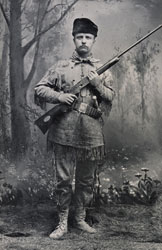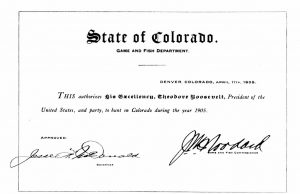“It is also vandalism wantonly to destroy or to permit the destruction of what is beautiful in nature, whether it be a cliff, a forest, or a species of mammal or bird. Here in the United States we turn our rivers and streams into sewers and dumping-grounds, we pollute the air, we destroy forests, and exterminate fishes, birds and mammals — not to speak of vulgarizing charming landscapes with hideous advertisements. But at last it looks as if our people were awakening.” — Theodore Roosevelt

After decades of mining, logging, extracting, and building, Americans in the first decade of the twentieth century began to realize that the American wilderness was a finite resource. The “Conservationist President” Roosevelt and other conservationists like John Muir helped to call Americans’ attention to the rapid loss of America’s wilderness. Numerous National Parks (including Colorado’s Mesa Verde) and National Monuments were designated during Roosevelt’s presidency (1901-1909).
In 1906 President Roosevelt signed the Antiquities Act, the first federal law passed for the purpose of protecting natural and cultural resources, including archaeological sites. The designation of Mesa Verde as a National Park in 1906 was a direct result of the Act, as were such sites as Devil’s Tower in Wyoming; Chaco Canyon in New Mexico; Arizona’s Petrified Forest and the Grand Canyon; and Washington’s Mount Olympus, among others. Colorado’s U.S. Senator Thomas Patterson was among the sponsors of the Antiquities Act (you can check out his biography, Tom Patterson: Colorado Crusader for Change, from our library).
Amidst the legislation occurring at the federal level, the state government here in Colorado was also working to address environmental concerns. Governor Henry Buchtel established the Colorado Conservation Commission following a 1908 White House governor’s conference called by President Roosevelt. Governor John Shafroth (whose biography, Honest John Shafroth: A Colorado Reformer, can also be checked out from our library) expanded the Colorado Conservation Commission, and in 1910, the commission issued a report to Governor Shafroth which is now available online through our library. The report includes the official proceedings of the commission; resolutions they adopted and state legislation they suggested; and several essays from local notables advocating for conservation. This publication is a significant primary source document that can be useful to students, historians, and policymakers who are researching the history of the conservation movement in Colorado and the United States.

- How to Spot the Differences Between Eagles and Hawks - August 16, 2021
- How Transportation Projects Help Tell the Story of Colorado’s Past - August 9, 2021
- Time Machine Tuesday: The Night the Castlewood Canyon Dam Gave Way - August 3, 2021